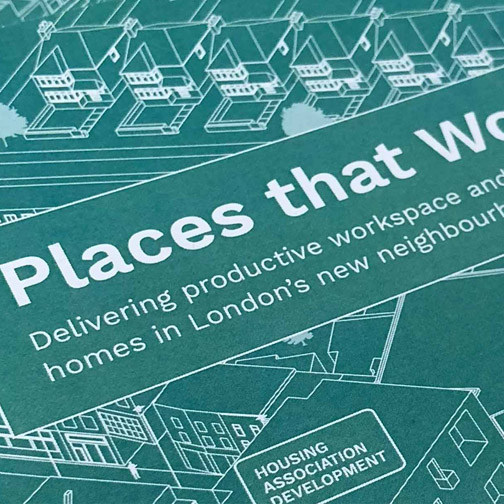Creating Places to Work

A coalition of regeneration experts have today outlined plans for a ‘New London Mix’ of housing and commercial space, which could support growth and increase current light industrial floorspace supply by up to 20%. The report, ‘Places that Work', is the result of a collaboration between GVA, Architecture 00, Dan Hill and Centre for London. It sets out how London can meet its growth challenges by mixing a wide range of employment space with residential and other uses, and outlines the policy reforms needed to achieve this.
The ‘New London Mix’ is focussed on the significant delivery potential of mixing a wide range of commercial space with residential and other uses, which should complement simply protecting or intensifying industrial land for solely employment use. This approach can create significant local benefits by retaining and growing existing and new businesses, allowing for additional much-needed homes to be delivered and underpinning an inclusive and sustainable model for urban growth.
This report explores how the ‘New London Mix’ can be provided both in existing industrial areas where the new London Plan might allow limited land release for mixed development if no net loss was achieved. However, perhaps more crucially, it considers how this mix would work in spaces that traditionally sit outside of employment areas, such as the edge of town centres, in estate regeneration or in transport-led housing growth areas, to not only protect employment land, but also in-effect create it.
The potential scale is significant with a future opportunity to deliver 4 million sq m of space as part of this mix, in many areas it can already be shown to be viable, either today or with minor improvements to current market conditions.
The report goes on to make several key recommendations to the government and private sector in order to achieve this mix:
- Establishing a significant London-wide Commercial Space Investment Fund that generates co-investment to accelerate and support the provision of new forms of mixed residential and employment development that accommodate industrial space.
- Establishing area-based Local Economic Growth Companies to purchase, hold and manage employment space from an early stage in the development cycle with a focus in Opportunity Areas where there is potential for mixed employment and residential development at scale.
- Developing enhanced and updated planning policies, area frameworks and development management approaches and good practice guidance at both a regional and local level to support effective delivery of mixed employment and residential schemes.
- Delivering five trailblazing projects by 2022 that demonstrate a range of conditions, typologies and delivery routes, exploring social impact and diverse investment opportunities supported by a longitudinal research programme.
Martyn Saunders, Director of Regeneration and Spatial Planning at GVA said: “It is time to face not just the scale of the challenge, but also the opportunity that London faces. The basis of current policy on ‘no net loss’ and protection is helpful, but we have much to gain from shifting our thinking to what we can create, and achieve ‘net gain’ across London. This means we need to consider a new approach that will deliver the levels of diverse commercial and residential space that London needs by expanding the conversation to include creation as well as protection, with the report suggesting this approach could deliver significant new economic capacity for London, increasing current light industrial supply by 20% in order to accommodate demand from a growing urban servicing sector, just in time production, high value advanced manufacturing and London’s burgeoning creative sector.”
Richard Brown, Research Director at Centre for London, said:
"London’s stock of workspace is being steadily eroded. Big industrial areas have been eaten away three times faster than planned in recent years.
"The Mayor’s draft New London Plan proposes tightening protections for strategic sites, but smaller scale workspaces are still vulnerable to being squeezed out by residential redevelopment.
"To ensure success in times of economic uncertainty and rapid technological change, London needs adaptable employment space as well as homes, workshops as well as logistics sheds, scrappy studios as well as smooth office blocks. New London Mix offers a model of development that can meet these needs, and in doing so create places with vitality, resilience and character."
Daniel Hill, said: “To achieve a “New London Mix” and bring it into the mainstream we need collaboration through the private, public and housing association sectors, new approaches in policy and funding, and to overcome persistent institutional barriers across London that prevent such solutions from progressing. This report is a call for the ‘New London Mix’ to become a crucial pillar in London’s Good Growth policy.”
Joost Beunderman, Director at 00, said: “This report shows how we can achieve a net gain of new employment space, but also how that can create better places, that are in sync with how we know urban innovation and 21st Century supply chains actually work. Particularly with traditional retail and restaurants under pressures in town centres and high streets, putting more diverse economic activities at the heart of places will make them more vibrant, inclusive, sustainable and resilient in the face of an ever-changing economy.

